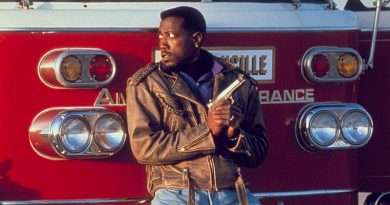Backdraft at 30: Still the Best Firefighter Film of All Time
Of all the firefighter films that have been released over the last few decades from The Towering Inferno (1974) to Ladder 49 (2004), Only the Brave (2017) and even HK/China productions seen in Lifeline (1997) and The Bravest (2019), the 30-year-old Backdraft still ranked the best among them all.
Yes, in case you have forgotten, Backdraft was released back in 1991. Or more specifically, May 24, 1991 during the Memorial Day weekend. It headed straight to No. 1 at US$15.7 million during the first four days and remained on the top spot for two weeks in a row. It even famously beat Bruce Willis’ US$65-million vanity project of Hudson Hawk, which also opened during that same weekend and made its debut at the No. 3 spots with just US$7 million.
Backdraft, which reportedly cost US$40 million to produce, was a hit with a worldwide total of over US$150 million. The film even earned three well-deserved Oscar nominations including Best Sound, Best Sound Effects Editing and Best Visual Effects. It went home empty-headed, thanks to a more qualified certain film that beat Backdraft in the technical award categories. That film in question was none other than James Cameron’s Terminator 2: Judgment Day.
I recently revisited Backdraft and even after all these decades, I was still blown away (no pun intended) by the impressive fire effects used for the film. And by effects, I mean most of the infernos that you’ve seen here are done in a practical manner. The kind that Hollywood would think twice to produce something as big as Backdraft in today’s CGI age, particularly when you talk about having lots of real fire on set.
Under the direction of Ron Howard (back when he still knows how to make crowd-pleasing blockbusters during the 90s era), he certainly put a lot of effort to make Backdraft as visceral and realistic as possible. In order to get the effects right, the special effects crew went as far as conducting a fire test three months before the filming began.
According to an Entertainment Weekly article published in 1991, the fire test was a combination of “alcohol, kerosene, diesel fuel and propane” and had them tested on a “specialised burn stage”. Allen Hall, who was the special effects and pyrotechnics creator in this film, built special devices nicknamed “Big Bertha” and “Ash-o-matic” for the fire sequences. The former refers to a huge steel tank that could hold a whopping 378-litre (100 gallons) capacity and able to release a “60-foot-by-20-foot wall of fire”. The latter, in the meantime, capable of ejecting smoke and “burning bits of cardboard” into the air — a result that would “simulate the swirling ash of a real fire”.
Although Backdraft did rely on some visual effects works from Industrial Light & Magic (ILM), they were mainly used for the superimposition that placed the actors over the separately-filmed fire scenes. Even with the added visual effects, it was amazing enough to know that according to special effects foreman Clay Pinney, 95% of the footage was filmed live on location.
While the fire sequences are undoubtedly the biggest selling point in this film, let’s not forget about the characters either. Blessed with a solid ensemble cast, Kurt Russell delivers one of his best performances to date as Lt. Stephen “Bull” McCaffrey. The same also goes with William Baldwin, who plays the younger brother Brian.
Robert De Niro and Scott Glenn provide strong supports as the arson investigator Captain Donald “Shadow” Rimgale and senior firefighter John “Axe” Adcox respectively. Even smaller roles such as the late J.T. Walsh (who died in 1998) is perfectly typecast as the slimy alderman Martin Swayzak while Donald Sutherland shows up in a memorable cameo as the Hannibal Lecter-like arsonist Ronald Bartel.
Whereas Howard does a great job bringing out the best in his actors, the female stars are sadly underutilised, even the fact he got good actresses including Jennifer Jason Leigh and Rebecca De Mornay.
The plot was actually by a real ex-firefighter Gregory Widen, who used to work in the profession for three years. Widen’s hands-on experience did help to give his screenplay an extra edge, particularly in the scenes where it concerns the profession and the fascinating term of “backdraft”. The film is also filled with lots of melodrama from the conflicts between the two brothers (Sean and Brian McCaffrey) to family problems (Rebecca De Mornay’s role as Stephen’s estranged wife Helen, who separated from his husband). And yet, the otherwise heavy-handed melodrama does work surprisingly well in its favour, thanks largely to the strong and consistent characters throughout the film.
Clocking at over two hours long (137 minutes, to be exact), it’s hard not to ignore the fact that Backdraft suffers from an overplotting narrative structure. Other than the major theme about the lives of firefighters and the aforementioned melodramas, the film also wanted to explore the mystery angle. This can be evidently seen with the scenes involving Rimgale’s investigation surrounding the mysterious victims all burned to a crisp from the result of a backdraft. While I did enjoy the multiple directions that Howard trying to cover everything here, the mystery part remained the most underwhelming moment in this film.
Following Widen’s screenplay work in Backdraft and five years prior after making his writing debut in 1986’s Highlander, he went on to write and direct the 1995 cult classic The Prophecy starring Christopher Walken. In 2019, he did return to write the unlikely direct-to-video sequel of Backdraft 2, which reunited two of the original stars including William Baldwin and Donald Sutherland.
Ron Howard was on the roll during the 90s and after the success of Backdraft, he subsequently made two of his other biggest hits including Apollo 13 (1995) and Ransom (1996).




